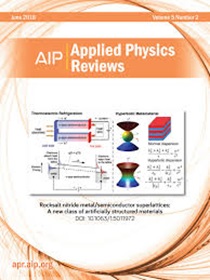Smart biomaterials in healthcare: Breakthroughs in tissue engineering, immunomodulation, patient-specific therapies, and biosensor applications
IF 11.6
1区 物理与天体物理
Q1 PHYSICS, APPLIED
引用次数: 0
Abstract
Smart biomaterials have significantly impacted human healthcare by advancing the development of medical devices designed to function within human tissue, mimicking the behavior of natural tissues. While the intelligence of biomaterials has evolved from inert to active over the past few decades, smart biomaterials take this a step further by making their surfaces or bulk respond based on interactions with surrounding tissues, imparting outcomes similar to natural tissue functions. This interaction with the surrounding tissue helps in creating stimuli-responsive biomaterials, which can be useful in tissue engineering, regenerative medicine, autonomous drug delivery, orthopedics, and much more. Traditionally, material engineering focused on refining the static properties of biomaterials to accommodate them within the body without evoking an immune response, which was a major obstacle to their unrestricted operation. This review highlights and explains various engineering approaches currently under research for developing stimuli-responsive biomaterials that tune their outcomes based on responses to bodily factors like temperature, pH, and ion concentration or external factors like magnetism, light, and conductivity. Applications in soft and hard tissue engineering, 4D printing, and scaffold design are also discussed. The advanced application of microfluidics, like organ-on-a-chip models, extensively benefits from the intrinsic smart properties of biomaterials, which are also discussed below. The review further elaborates on how smart biomaterial engineering could revolutionize biosensor applications, thereby improving patient care quality. We delineate the limitations and key challenges associated with biomaterials, providing insights into the path forward and outlining future directions for developing next-generation biomaterials that will facilitate clinical translation.医疗保健中的智能生物材料:在组织工程、免疫调节、患者特异性治疗和生物传感器应用方面的突破
智能生物材料通过推动旨在在人体组织中发挥作用的医疗设备的发展,模仿自然组织的行为,对人类医疗保健产生了重大影响。虽然在过去的几十年里,生物材料的智能已经从惰性发展到活跃,但智能生物材料通过使其表面或体积基于与周围组织的相互作用而做出反应,从而使其具有类似于天然组织功能的结果,从而进一步发展。这种与周围组织的相互作用有助于创造刺激反应生物材料,这在组织工程、再生医学、自主药物输送、骨科等领域都很有用。传统上,材料工程的重点是改进生物材料的静态特性,使其在不引起免疫反应的情况下适应体内,这是其无限制操作的主要障碍。这篇综述强调并解释了目前正在研究的各种工程方法,用于开发刺激响应生物材料,这些生物材料根据对身体因素(如温度、pH值和离子浓度)或外部因素(如磁、光和电导率)的反应来调整其结果。并讨论了其在软硬组织工程、4D打印、支架设计等方面的应用。微流体的先进应用,如器官芯片模型,广泛受益于生物材料固有的智能特性,这也将在下面讨论。这篇综述进一步阐述了智能生物材料工程如何彻底改变生物传感器的应用,从而提高患者的护理质量。我们描述了与生物材料相关的局限性和主要挑战,提供了对前进道路的见解,并概述了开发下一代生物材料的未来方向,以促进临床转化。
本文章由计算机程序翻译,如有差异,请以英文原文为准。
求助全文
约1分钟内获得全文
求助全文
来源期刊

Applied physics reviews
PHYSICS, APPLIED-
CiteScore
22.50
自引率
2.00%
发文量
113
审稿时长
2 months
期刊介绍:
Applied Physics Reviews (APR) is a journal featuring articles on critical topics in experimental or theoretical research in applied physics and applications of physics to other scientific and engineering branches. The publication includes two main types of articles:
Original Research: These articles report on high-quality, novel research studies that are of significant interest to the applied physics community.
Reviews: Review articles in APR can either be authoritative and comprehensive assessments of established areas of applied physics or short, timely reviews of recent advances in established fields or emerging areas of applied physics.
 求助内容:
求助内容: 应助结果提醒方式:
应助结果提醒方式:


